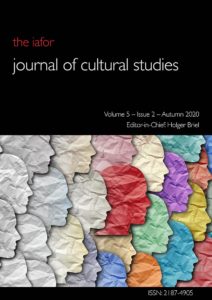Dear Readers,
 If in the last issue, published about six months ago, I had timidly expressed the hope that by the time the publication of this issue of the IAFOR Journal of Cultural Studies had rolled around, things might have gone back to normal, by now, dear readers, we all know that I was sadly mistaken. On the contrary, one can easily argue that things have become much worse since then; COVID-19 is still with us, many people (arguably many more than necessary) have died from it, receding economies have brought hardship to millions and many freedoms thought inalienable have been curtailed, hopefully only temporarily so. Academia is one of the worst hit sectors, with students unable to travel, normal teaching services suspended and conference travel all but dead.
If in the last issue, published about six months ago, I had timidly expressed the hope that by the time the publication of this issue of the IAFOR Journal of Cultural Studies had rolled around, things might have gone back to normal, by now, dear readers, we all know that I was sadly mistaken. On the contrary, one can easily argue that things have become much worse since then; COVID-19 is still with us, many people (arguably many more than necessary) have died from it, receding economies have brought hardship to millions and many freedoms thought inalienable have been curtailed, hopefully only temporarily so. Academia is one of the worst hit sectors, with students unable to travel, normal teaching services suspended and conference travel all but dead.
No matter how one looks at the present, it is clear that humanity will not be able to return to the old normal; it is too early to say, but many things have already changed. Online services have skyrocketed and will continue to do so, business travel and whole business models have been taken over by new forms of work organisation (e.g. home office), and Zoom, a video service barely know six months ago, has become a household name and an interface default.
While not being able to tackle issues at large, in the pages of the current issue of this journal, we can at least offer some travel-related sensations, as the topics therein allow one to circumnavigate the globe through the pages and topics to follow.
In this issue:
Article 1
The issue opens with a short thematic focus on architecture beginning with Adeyemi Akande’s Manifestations of Orí (Head) in Traditional Yorùbá Architecture. This text examines Yorùbá architecture and claims cogently that at least some of its features are situated in close proximity to Yorùbá spirituality and religion. Especially the form of the roof corresponds strikingly to the spiritual concept of Ori (head) in Yorùbá mythology. Thus, while Yorùbá spirituality might be in decline due to the young striving for more western ideals, they would do so at least under a spiritual and culturally determined traditional roof.
https://doi.org/10.22492/ijcs.5.2.01
Article 2
The second article, ArchDaily and Representations of Domestic Architecture in the era of Digital Platforms by Bruno Cruz Petit and Tomás Errazuriz Infante, examines today’s leading architectural website, ArchDaily. Having originally been launched in Chile, it has now moved to New York and, as the authors argue, is globally influential. This influence, however, comes at a price. Local differences, visible when publications were still local, have been usurped by images pretending to suggest a global style, akin to what photographs on airbnb have done to interior decoration, suggesting and requesting a single style as “global”. But the authors do not stop there: they claim that the website has also made global and disseminated a writing style full of clichés and grandiosity, bearing little or no correlation to the objects described; worse yet, as their research demonstrates, the objects are displayed devoid of functionality; humans play a decorative role if any at all, thereby perverting the original meaning of houses as shelters.
https://doi.org/10.22492/ijcs.5.2.02
Article 3
Giulia Zaninelli’s Small Palm Oil Plantation as Political Arena: Environmental Narratives Among Workers and NGOs in Aceh, Indonesia tackles a different problem, although it does contain a strong global element as well: that is the world’s unstoppable hunger for palm oil products. There have been many articles written on the issue of how palm oil plantations are impacting negatively on the environment in which they are placed. Zaninelli readily agrees to this fact, but her perspective is more on the social ramification these plantations have, and especially so on the indigenous populations of Banda Aceh, Sumatra. Having lived in several villages in the area, she has become a keen participant observer and reports on changes in villages over the last 20 years or so. Her perspective does not privilege the villagers though, as many other articles do; she also questions some of the motives of the activist involved in the struggle against big palm oil companies. She does not accuse them of intentionally misunderstanding the situation; rather, she shows how their own background as oftentimes privileged students from urban middle-class families might lead them to misread what is actually going on in the villages. The article ends with an appeal to all concerned to work together rather than against each other to find solutions.
https://doi.org/10.22492/ijcs.5.2.03
Article 4
Moving far southeast from Indonesia, Justin Matthews and Angelique Nairn's discussion takes on nudity in New Zealand. Their Lights, Action, Naughty Bits: A Thematic Analysis of New Zealanders’ attitudes to “Naked Attraction” analyses a number of New Zealand media and their interpretation of the reality show Naked Attraction, originally having aired on Britain’s Channel 4 and then transplanted to New Zealand, among other places. They find that New Zealanders do indeed have a healthy attitude regarding nudity and readily proclaim this fact as well. While the show still remains a reality show, with all the drawbacks such a format includes, viewers found it “to be refreshing, especially because the show offered real people that were relatable and validated the self-concepts of many commenters.”
https://doi.org/10.22492/ijcs.5.2.04
Article 5
Finally, Paweł Zygadło’s Face and Authority: Cultural Challenges of Teaching in China takes us to China and gives a first-hand approach of teaching as a foreigner, a Lao wai (老外), in China. Zygadło, who for many years has been teaching in Taiwanese and mainland China universities, analyses recent western theories of pedagogy and how these need to be re-examined in the face of Chinese cultural realities. These realities do not take away from their force, for instance regarding the teacher-student relationship, but tweak it in certain ways. Understanding these dynamics is beneficial for both the student and the teacher and allows for teachers to become more efficient in their teaching. Especially the concept of “face” plays an important role here, as Zygadło convincingly argues.
https://doi.org/10.22492/ijcs.5.2.05
I wish you safe and instructive travels on the pages of this issue!
Holger Briel
Editor-in-Chief

